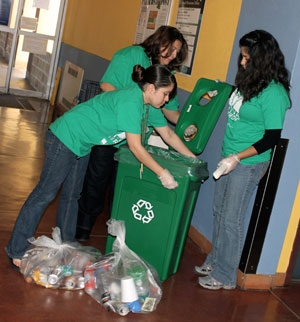
Officers from the Student Government Association gather recyclables in the Student Center. Photo by Jose Casarez
The students, faculty and staff of Palo Alto College are reducing the number of items thrown into the trash every day. From January through September 2010, Palo Alto kept 42,885 pounds of recyclables out of the city’s landfill.
According to the Environmental Protection Agency, 80 percent of what we throw away is recyclable, yet the recycling rate in the United States is only 30 percent. In San Antonio, the recycling rate is only 18 percent. Items that may be recycled include paper, cardboard, empty plastic, empty metal and empty glass.
Recycle bins are available all over campus for students, faculty and staff to use. Volunteers, who take the time to collect recyclables in their buildings each week, help make Palo Alto College a more environmentally friendly campus.
Cynthia Sanchez, the lead access services librarian, volunteers. "Everybody works to recycle in the library. It’s really a team effort," she said.
At Palo Alto College, the green recycle bins with the two-holed lids are for empty plastic, empty glass and empty metal containers. It is important that all drinks are drained and that trash is not thrown into the bins. Gray bins, found in offices and lab, are for paper only. Cardboard should be broken down and placed next to the gray bins.
Jesse Alvarez, a sophomore Communications major, said, "I try my best to recycle here on campus and at home. When we recycle, we are making a little action that can create a better reaction."
Recycling seems like it can be difficult, but every bit of recycling makes a difference. According to the National Recycling Coalition, every 2,000 pounds of paper that is recycled saves 17 trees. The energy that is saved when one glass bottle is recycled is enough to light a light bulb for four hours, and recycling one aluminum can saves enough energy to power a television set for three hours.
Mauro Ortegon, the foreign languages lab coordinator and recycling volunteer said, "Recycling keeps the environment clean, and all around it’s just better for Mother Earth."
Palo Alto College is working to become a green campus, and there’s a lot you can do to help. Turn off the lights when you are the last to leave a room. Place recyclable items in the recycling bins instead of the trash. Ride a bike, take the bus or walk to school. For a list of other green things you can do, check out the Viva Verde pledge in the Green Committee Info section of the www.alamo.edu/pac/vivaverde page.
If you would like to do more, join the Go Green! ¡Viva Verde! Committee at Palo Alto College. Contact the committee’s chair, Dr. Denise Barkis Richter, at (210) 486-3237 or e-mail her at drichter@alamo.edu. Not only does the committee focus on recycling, but it also focuses on environmental citizenship, natural habitat, indigenous wildlife, air quality and energy reduction, water conservation, green purchasing and green building renovation/construction.
The United States is 5 percent of the world’s population, but it uses 25 percent of the world’s natural resources, according to the Environmental Protection Agency.
Palo Alto College is making a progress, in reducing that percentage, so next time you see a volunteer emptying out a recycle bin, thank him or her and offer to help.